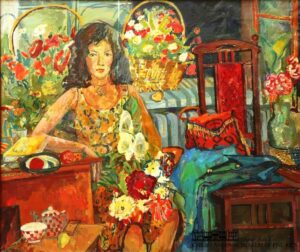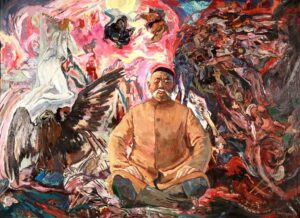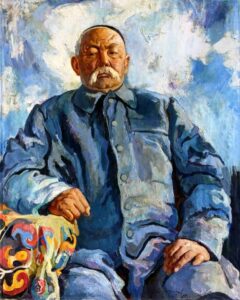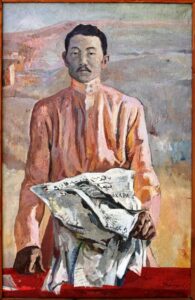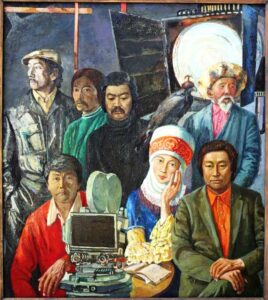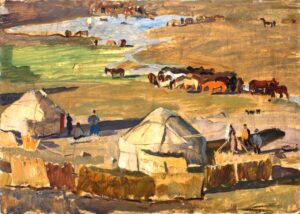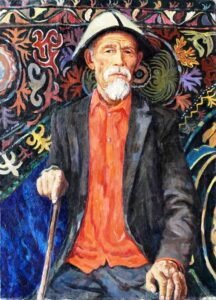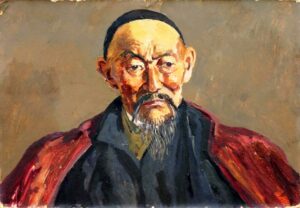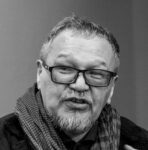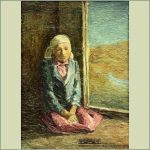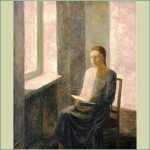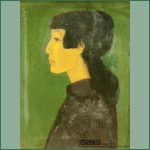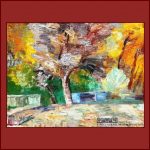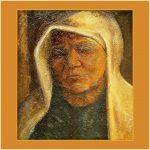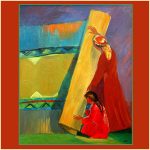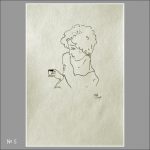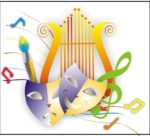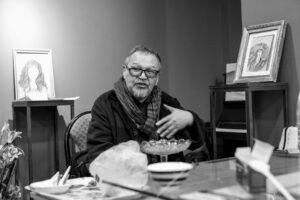
Gamal Bokonbaev, an art critic, author of 12 books, including a large volume “Fine Arts in Kyrgyzstan” (2007, 410 p.), books: “Fine Arts of Kyrgyzstan: periods of development. 1927-2015, painting, graphics, sculpture, contemporary art “(2015, 160 p.)”, The Union of Artists of Kyrgyzstan: Activity and Creativity “(2016, 234 p.), as well as the organizer of several dozen exhibitions in Kyrgyzstan. An architect, designer, artist by education.
Suimonkul Chokmorov is an artist and film actor who is not necessary to be introduced to in our country. He is loved by the people. At the same time, a professional look at his artistic work is of great interest.

Still life with self-portrait. 1976
Oil on cardboard, 63.5×49
The studio is in a creative mess. On the table are cans of paints, bottles of linseed oil and various thinners. Brushes, rags, nippers, faceted glass. Creator’s tools are like a work of art! Things that are dear to the painter’s heart, necessary, familiar, and there is no disorder here, everything is at hand, and smells specifically. Who does not know this fragrance, he does not know what oil painting is! Separately, so as not to get dirty, art books – how could it be without them.
The table ends and the canvas stretchers are visible, standing right on the floor. One of them shows a self-portrait in the role of Bakhtygul. In 1968, Suimenkul Chokmorov played the leading role in the brilliant film by Bolot Shamshiev “Shot at the Karash Pass”. The role of Bakhtygul is the first role followed by others in a successful actor career of a painter. As if another Chokmorov is looking at the artist. There is a question in the look. The picture is a postmodern collage: the main part of the work, light gray, is painted in the style of the and the self-portrait looks like it comes from another life, a different color, a different plasticity. (“Bubnovy valet” means “Jack of Diamonds” in Russian – Russian art group, the largest creative association of the early avant-garde, which existed from 1911 to 1917). The actor never forgot about his first profession. They say that to the question: “Who is he, an actor or an artist?” Suymenkul Chokmorov invariably answered – an artist!
MORE ABOUT “BUBNOVY VALET”
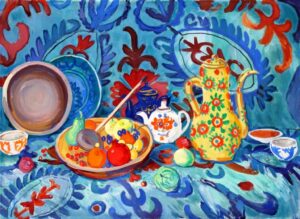
Blue still life. 1989
Oil on canvas, 73×100
The background is a blue tablecloth decorated with patterns – blue, red, brown. Flat patterns and blue dominate. The patterns on objects are smaller, they thicken the mass and make you feel the air. Volume is indicated by light shadows and whimsical penumbra. Two vertically standing dishes: one merges with the background, the other is metallic. Two teapots, blue and white. A bowl and a saucer next to it. These “double” comparisons play «further-closer» and create a sense of space. There are also two main items: first, a ceramic dish with round fruits and a wooden ladle; and second, a large yellow jug with painted red circles and green petals. The beauty of the living and the beauty of the painted. Lonely objects, bowls and fruits, are scattered and participate in the general roll call of the movement of masses and air. Who is in charge here? Undoubtedly, the focus of volumes on the ceramic dish; of course, patterns on yellow stand out among patterns on white, light blue, blue; if you look closely, you will notice that the central axis runs along the blue teapot and the glare on the cherry. But the most, the most important is the strangest! It’s a metal cup! Travel mug? Aluminum? Why do you need this mundane kitchen utensil amid this fantastic extravaganza of patterns? It falls out of the general stylistics, argues with beautiful planes. However without it, the still life would be too blue, too lightweight.
Actress. 1977
Oil on canvas, 111×131
In the 70s, Suimenkul Chokmorov acted a lot in films and managed to paint. The desire to have time for everything determined the artistic method – ala prima, in one movement. The drawing is simplified: dominated by a flexible line, wayward dots and spots. The palette changes: less earth, ocher – more aniline shades, open and transparent. This method better conveys the frantic pace of modern life.
In 1975, Suymenkul Chokmorov starred in the film “Red Apple” with Tattybyubu Tursunbaeva, in 1977 in the film “Ulan” with Natalia Arinbasarova. You can look for analogies, but the actress in the portrait is not a specific character, it is an image.
After the premiere, the room is littered with flowers. They are everywhere: on her knees, in baskets, in a jug, in a glass. Roses, peonies, lilies and hydrangeas reign in compositional color chaos. It is complemented by a creative mess: a raincoat and a bag are thrown onto a chair; on a stool a teapot with a bowl, a pear. A mess on the table. Outside the open window, the city turns frighteningly black. The actress has a not at all happy expression on her face: she was left alone. After a noisy evening, fatigue came over her. A new character came to painting, not the builder of the future and not the hero of the glorious past – the bearer of a paradoxical urban culture, where success coexists with loneliness and a sea of flowers evokes sad moods.
Dedication. Sayakbai Karalaev. 1974
Oil on canvas, 131×179.5
SAYAKBAY KARALAEV (1894-1971) – the great Storyteller, Manaschy. He is often referred to as the “Homer of the 20th century.” Sayakbai sits on the carpet, hands on his knees. Eyes closed, he is all immersed in the universe of the Great Epic and is ready to transmit the energy of his ancestors through himself, to initiate people into the spiritual treasury of the people. The duel between Manas and the enemy is in full swing. There is a battle for the native land, for the future of a united people: On the left, Kanykei (the wife) is watching the outcome of the battle. On the right are those fighting and defeated. Expression of forms and colors. Day and night, light and dark, chaos and contrasts! Here is what Chyngyz Aitmatov wrote about the Storyteller: “… Karalaev’s performing style is full of emotional intensity: rhythm, passion, inspiration, and next to it – longing, grief, emotion, tears – next to it is valour, determination and courage. And again thoughts, laughter and crying”. But the artist chose a different path and the image of the Storyteller is more of a symbol. He is detached from everything worldly. This is an unusual interpretation! And is it correct? Questions arise …
Today this work is the most powerful pictorial variation of the Great Epic. This painting is perceived as a creative testament of the master. Why was it possible to experiment so boldly in Soviet Kyrgyzstan? Perhaps then there was an understanding that it was as a result of painful searches, mistakes and failures that real art appears and the heights of the spirit are reached! And questions arise …
Portrait of Sayakbai Karalaev. 1971
Oil on canvas, 123.5×99.5
SAYAKBAY KARALAEV (1894-1971) – the great Storyteller, Manaschy, a symbol of the spiritual greatness of the people. Batyr is sitting at the table, wearing a blue chapan. Behind the blue sky and white clouds. The edge of the tablecloth with a national pattern is visible. But the details are not of interest to the master – he is working on the symbol! The features of the storyteller acquire scale and even a large scar on the forehead is inscribed as a seal of the chosen one. Calm, majestic, directed upward. The tension clenched into a fist, sacred knowledge shines through in the sparkle of the eyes. Something unspeakable in the clouds. Here is how Chyngyz Aitmatov wrote about the Storyteller: “… When you look … at the plasticity of his face, gestures, expression of his eyes, when you listen to this person with an exceptional gift of artistic transformation, it seems that he himself is, as it were, the personification of the epic beginning …”
The artist spent a long time preparing for a large thematic painting. He searched, tried, worked at home with the person being portrayed. Signs of the times always remain at work, perhaps the hardships of life that haunted the narrator, fatigue from loud veneration, are reflected. And the specifics of the elegant decor on the tablecloth breaks into the composition as if it keeps the Chosen One from completely merging with the Epic.
Portrait of Sayakbai Karalaev “Homer of the XX century”. 1966
Oil on canvas. 137.5×104
SAYAKBAY KARALAEV (1894-1971) – the great Storyteller, Manaschy. Sayakbai Karalaev’s version of the Manas epic is recognized as one of the most complete. Was born in the Ton district of the Issyk-Kul region. During the events of 1916, he fled to China, returned a year later. In 1918 he joined the Red Guards detachment. From 1921 to 1931 he worked as chairman of the village councils of the Issyk-Kul region. In 1936 he became a soloist of the State Philharmonic. People’s Artist of the Kyrgyz SSR (1939), awarded three Orders of the Red Banner of Labor, the Order of the Badge of Honor.
The narrator is sitting on a high seat, as if on a throne, in a green jacket, with one hand resting on a cane, with the other squeezing a knee. Sheep sheepskin coat on the shoulders. Abstract spots form the background space, as if a piece of the sky is peeping through the dense clouds. Shades of ocher, green, black – a realistic portrait, but not everyday. The artist expressed the greatest tension that manaschi experiences. A stern look, furrowed brows, pursed lips. By an effort of will, the back is straightened, the expression of the hands is unusually expressive. The artist painted several portraits of the Storyteller, changing colors, general tonality and details, but the general spirit of the compositions remained unchanged: a great man, a huge universe of souls, containing a huge universe of the spiritual life of the people.
Portrait of the revolutionary SARYKULAKOV. 1972
Oil on canvas, 100×65
KOJOMURAT SARYKULAKOV (1892-1918) was one of the active participants in the struggle for a new power in Kyrgyzstan. Studied in Verny, Kiev, Kazan. After the February democratic revolution, he returned to Kyrgyzstan and was actively involved in political life. On September 10, 1917, he was elected chairman of the BUKARA (Poor) Union. He died in 1918.
A batyr is standing at a table made of red cloth, holding a newspaper in his hands. A learned man, an intellectual and a democrat, appeals to the mind of the people! Simplicity is the pathos of the poor. There is nothing superfluous on the table. A straight line and the edge of a piece of paper. Nothing superfluous in clothes: a pale pink blouse. Poor buildings are visible at the very edge of the gray steppe. The face is pale, but the hands are dark from sunburn and peasant work. Red, white newspaper, black letters, dark hair and hands. Everything else is light! Subtle shades of pink, blue, purple, yellow and green. In the 70s, it was fashionable to interpret the revolution as a light romance. In this case, it is justified. The hero will die and will not learn about hunger, repression, the collapse of revolutionary undertakings. What kind of newspaper is he holding in his hands? You can see the Arabic script and in the Cyrillic alphabet part of the inscription: “BUKARA”. Until 1924, the Kyrgyz used newspapers in Russian, Kazakh, Uzbek and Tatar. Only in November 1924 the first Kyrgyz newspaper “Erkin-Too” (“Free Mountains”) appeared. The newspaper was printed in Arabic script. Perhaps the artist shifts the time to make it clear: Print – Knowledge – Freedom and Prosperity!
Filmmakers of Kyrgyzstan. 1986
Oil on canvas, 134,5×120
Above, from left to right: SUYMENKUL CHOKMOROV, directors GENADY BAZAROV and BOLOT SHAMSHIEV. On the far right – an old man with a golden eagle, from which film? – do not define. Reminiscent of the storyteller, the agile MOMUN from the movie “The White Steamer”. But, most likely, this is a generalized image. Below: cameraman KADYRZHAN KYDYRALIEV and director TOLOMUSH OKEEV. In the middle not the image of a Kyrgyz beauty. Why didn’t the artist depict the beautiful TATYBYUBYU TURSUNBAEVA? Perhaps the author decided to invite the “image” to this “men’s club”? Perfect so that others would not be offended? How many complaints this theatrical doll has caused!
In fact, the artist placed the authors of the Kyrgyz miracle on the picture in the cinema of Soviet Kyrgyzstan in the late 60s and early 70s. True, there is no MELIS UBUKEEV and ALGIMANTAS VIDUGIRIS. Perhaps the artist decided to portray the people closest to him. He worked a lot with OKEYEV, KYDYRALIEV, SHAMSHIEV, made a portrait of GENNADY BAZAROV. There is an opinion that the author did not include himself, but portrayed the operator NURTAY BORBIEV …, this is a controversial opinion. In general, the author did not strive for literal similarity – he strove to express his understanding. CHOKMOROV looks to the left, out of the composition, and the old man with the golden eagle to the right, BAZAROV, KYDYRALIEV and … the doll are looking directly at the viewer. SHAMSHIEV and OKEEV are creators deep in themselves. Each is one of the facets of Kyrgyz cinema: a person from the OKEEV people, an urban intellectual BAZAROV, an emotional SHAMSHIEV, a reasonable Kydyraliev. And the author himself is an artist, an actor with an expressive appearance and an amazing destiny.
The accent is a huge ball of cinematic soffit, a spotlight in a black square. In front of the operator – a movie camera, there is no such thing anymore, everything has been replaced by digital technologies. Opened scenario on the round table. The gray-black range prevails. Red, orange, pink, green, blue, arranged compositionally. Meaning? All different, all antipodes… all did not get along with each other … And all together – our Miracle! This is the author’s idea of the concept of “Filmmakers of Kyrgyzstan”. Therefore, there were disputes. It is a pity that they did not become a discussion. A difficult task and an ambiguous picture. A rarity in the fine arts of Kyrgyzstan. I am a supporter of such tasks and such pictures!
Evening at the jailoo. 1967
Cardboard, tempera, 81х57.5
Below is something not entirely clear. Are there felt cloths hung to dry? Could they have just been made? Dried chi (it is tall, hard steppe grass, the stems of which are used by Kyrgyz for the production of mat) ? It might be a reed hedge, but why are fences on a jailoo? Everything can be explained simply if we assume that the action takes place on the set of the film. We needed canvases for some scene, so they made a props. Yurts stand a little higher, the inhabitants of the camp are visible. The middle of the composition is occupied by a school of horses, located near a mountain river, then a herd grazes on the shores of a small lake. Long shadows only emphasize the horizontal articulation of the composition. Written masterfully, transparently, subtly. Shades of ocher, with additions of green and blue, perfectly convey the velvety beauty of mountain meadows at sunset. Highlighted: a female figure in blue and an orange horse. What is the idea behind this work? Nature and man freeze in anticipation of the sunset? Kyrgyz artists knew how to create mood paintings. They did not become large canvases, but were appreciated as talented motives. And yet, what is the motive for creating this work? … In 1967 Bolot Shamshiev began shooting the film “Shot at the Karash Pass”. There are some great black and white camera shots on the jailoo (Kyrgyz summer pasture, usually alpine). Maybe the artist got carried away and decided to make his own pictorial interpretation of natural beauty? … In one of the final episodes of the film, Suimenkul swims across a cold mountain river. He catches a cold, relapses of lung disease. Overcoming monstrous pains, the hero finished the film to the end. Perhaps drying the felt is like Joseph Beuys (German artist, one of the main theorists of postmodernism). felt …. All this is far-fetched psychoanalytic nonsense! And, as you know, there is no Freudianism in Soviet and post-Soviet art criticism!
Self-portrait (Extraordinary Commissioner). 1976
Сardboard, oil, 63.5×49
In the film “Extraordinary Commissar” (1970), the artist played the role of the red commissar NIZAMETDIN KHOJAEV, a member of the Central Committee of the Communist Party of Turkestan, head of the revolutionary committee of the Fergana region. The great Kyrgyz actor played the great Uzbek communist and there was nothing strange about this in the USSR! Outstanding Uzbek director ALI KHAMRAYEV made a film at the Uzbekfilm studio, in a fraternal republic! Two years later he will shoot the film “The Seventh Bullet”, starring Suymenkul Chokmorov!
At this time, the artist works quickly, managing to appear in films, and this frantic pace determined the method of work – ala pima, in one movement. Intense red background, bandaged head, blue shirt and gray overcoat. The actor did not even have time to change clothes, move away from the image. And it turned out that he painted a self-portrait, with a palette and a brush in his hands, in the image of the red commissar, the Uzbek communist NIZAMETDIN KHOJAEV! There is no portrait resemblance here – this is an amazing cumulative portrait of the era!
Portrait of the People’s Artist Kirg. SSR A. Jankorozova. 1975.
Oil on canvas, 90×57.5
JANGOROZOVA ALIMAN (1914-1993) – theater and film actress. People’s Artist of the Kirghiz SSR (1967). She starred in such famous films as: “The Sky of Our Childhood”, “Scarlet Poppies of Issyk-Kul”, “Fierce”. Chon Apa (Grand Mother – in Kyrgyz) sits on the carpet, clasping her knee with her hands, in the national women’s headdress, ELECHEK, against the background of elegant carpets and different colors blankets stacked in a pile. Subtle and sophisticated in color, the drawing seems realistic, but the artist is not interested in similarity – he is interested in patterns! The face and clothing are whimsical patterns. Where do national patterns come from? From kind eyes! From a noble bearing! Full of the dignity of soft lines. From slightly curved lips, in which worldly wisdom is courteously hiding. Huge, weary hands are pushed forward. They do not fit into the plane of the picture! A justified reception. This portrait was a character in a small episode of the film “Red Apple” (1975, directed by Tolomush Okeev). Suimenkul Chokmorov in the title role, plays an artist who paints a portrait of his grandmother. The episode is a development of the plot, but during this time the artist has time to state the credo of the “asphalt Kyrgyz”: there are enough worries in the city; illness recedes when you work hard; you forget when you create. He liked the portrait and Chon Apa invites the artist to his village, to the mountains, to drink kumis, to gain strength and health.
Portrait of a veteran. 1985
Oil on canvas, 80.3×58
This is a portrait of a simple peasant: an old dark gray suit, orange shirt and some kind of non-standard, not pretentious kalpak (felt hat, a common Kyrgyz male headdress). Working kalpak: the crown is not high and the brim is lowered. He sits against the background of the carpet, as photographs are taken in aiyl (Kyrgyz village), and rests his hand on a stick. In contrast to the simplicity of the character, an elegant tush kiyiz, traditional embroidered wall carpet, played with all colors and shapes. It seems that it sticks out too much and prevents you from seeing the main thing. But in fact, this is a clever compositional move! Folk patterns are repeated in the form of a beard, wrinkles on the face, wrinkled hands. And a valiant posture appears, and in the look – dignity. A veteran is a small person, and this is his greatness! There was such a fashion among the Soviet intelligentsia of the era of stagnation. After Robert Rozhdestvensky’s poems “On Earth, Mercilessly Small …” (1969), medals and orders were no longer needed, even a ribbon was not needed! And for the glorification of the little man’s feat “there was not enough marble on the whole earth …”. The artist strove to depict the features of eternity. But a specific person posed. Who is he? Four Chokmorov brothers – Sultan, Cholponkul, Cholponbai and Namyrbek – fought. Cholponbai died in July 1941. The rest returned. Namyrbek served in the police. The eldest, Sultan, followed in his father’s footsteps, mastered blacksmithing superbly, had orders and medals. He died in 1995 at the age of eighty-seven. Maybe he posed for a portrait? There is no reliable evidence. Representatives of the large Chokmorov family were distinguished by their modesty and were in no hurry to go down in history. In modern Kyrgyzstan they would not be understood. What is such a simple person? Rewards Needed! Orders, medals! Proofs of success are needed! It is necessary to climb into history, jostling with elbows, into candidates-deputies, into officials-businessmen!
Manaschi M. Chokmorov. 1968
Oil on cardboard, 47.9х69.5
MAMBET CHOKMOROV (1896-1973) – one of the greatest storytellers of MANAS! Born in the town of Korumdu, Issyk-Kul region. In 1963-1973, employees of the Academy of Sciences of the Kirghiz SSR wrote down a unique version of the trilogy from Chokmorov’s words – “Manas”, “Semetey”, “Seytek”. The artist’s namesake has lived all his life in his native village, performing in a circle of fellow villagers with various episodes from the great epic. He did not want to live in a big city, did not want to adapt to concert activities and the regulation of creativity. The background is smooth, green-brown khaki. On the shoulders – a red ocher-colored chapan, on the head – a black skullcap (malakai). A dark gray suit, a shirt that looks like a military tunic, a white collar peeking out from under it. The expression on his face is stern, displeased. Frowning brows, pursed lips, prickly eyes. The aksakal understands his responsibility to the people – he is indebted to his gift. He’s at war! For spirituality, for heritage! Every day, hour, moment – he cannot relax. And the painting is appropriate. From the dark austerity of the background, the expression of strokes intensifies towards the center, breaking the symmetry of the eyebrows and eyes. The author probably understood that this was not enough for a large exhibition work … He would work for a long time on the portrait of Sayakbai Karalaev …. But this sketch can also tell the viewer a lot. This is a complete statement about the essence of creativity and the role of the artist.
Telegram-channel in Kyrgyz & Russian:
Санжарбек Данияровдун коомдук фонду
Фонд Санжарбека Даниярова
Subscribe if interested




